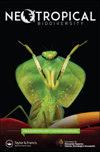Responses of Polylepis birds to patch and landscape attributes in the High Andes
IF 0.8
Q4 ECOLOGY
引用次数: 4
Abstract
ABSTRACT Habitat loss and fragmentation can devastate biodiversity, especially at regional and global scales. However, generalizing to individual species is challenging given the wide variety of intrinsic and extrinsic factors that shape species-specific responses – particularly among species that are specialists, generalists, or adapted to naturally patchy landscapes. In this study, we examined how patch and landscape attributes affected bird communities within Polylepis forest ecosystems, which are patchily distributed within landscapes of Puna grasslands and shrublands in the High Andes of Peru (3,300–4,700 m). We surveyed birds in 59 Polylepis patches and 47 sites in the Puna matrix, resulting in 13,210 observations of 88 bird species, including 15 species of conservation concern specialized on Polylepis. Data were analysed using Multi-Species Occupancy-Models (MSOM) and cumulative species-area curves. Species richness was generally greatest at mid-to-low elevations, within small fragments, and in landscapes with comparatively little forest cover; this was especially true for birds associated with the Puna matrix. Consistent with the hypothesis that Polylepis specialists are adapted to naturally patchy landscapes, we found no evidence that Polylepis specialists were sensitive to patch size, though two of nine species were positively related to forest cover within 200 m. Our work shows that small patches of Polylepis have high ecological value and that conservation of species of concern may depend more on retaining at least 10% forest cover within landscapes than on the presence of large patches of Polylepis.高安第斯山区水翅鸟对斑块和景观属性的响应
摘要栖息地的丧失和破碎化会破坏生物多样性,尤其是在区域和全球范围内。然而,考虑到形成物种特异性反应的各种内在和外在因素,特别是在专家、多面手或适应自然斑块景观的物种中,将其推广到单个物种是具有挑战性的。在这项研究中,我们研究了斑块和景观属性如何影响Polylapis森林生态系统中的鸟类群落,这些森林生态系统零星分布在秘鲁安第斯山脉(3300–4700米)的普纳草原和灌木林景观中。我们调查了59个Polylepis斑块和Puna矩阵中47个地点的鸟类,对88种鸟类进行了13210次观测,其中包括15种专门针对Polylepiss的保护关注物种。使用多物种占用模型(MSOM)和累积物种面积曲线对数据进行分析。物种丰富度通常在中低海拔、小碎片和森林覆盖相对较少的景观中最高;对于与普纳矩阵相关的鸟类来说尤其如此。与Polylapis专家适应自然斑块景观的假设一致,我们没有发现证据表明Polylapis专业人员对斑块大小敏感,尽管九个物种中有两个与200米范围内的森林覆盖呈正相关。我们的工作表明,小面积的Polylapis具有很高的生态价值,保护受关注的物种可能更多地取决于在景观中保留至少10%的森林覆盖率,而不是大面积的Polylipis。
本文章由计算机程序翻译,如有差异,请以英文原文为准。
求助全文
约1分钟内获得全文
求助全文
来源期刊

Neotropical Biodiversity
Environmental Science-Ecology
CiteScore
1.80
自引率
0.00%
发文量
39
审稿时长
24 weeks
 求助内容:
求助内容: 应助结果提醒方式:
应助结果提醒方式:


